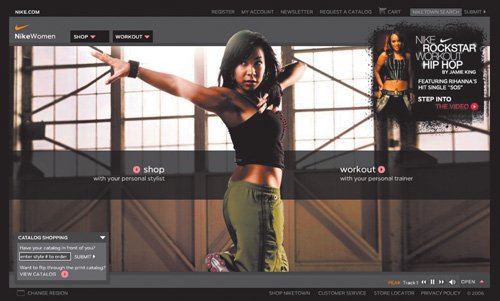Services and Branding
| Interaction designers can't design services without taking full account of branding. Indeed, one of the roots of service design is the "total brand experience" movement of the past two decades, in which marketers and brand managers try to make sure that every time a customer interacts with a company, they have a consistent, branded experience. While that is an interesting goal that still plays out for companies such as Nike (Figure 8.8), it starts from a different point of view than does service design: namely, from the company's point of view. Total brand experience asks, How can the company imprint itself on the customer? Service design, in contrast, asks, How can the customer's experience with the company be a positive one (and thus strengthen the brand)? Figure 8.8. Nike's Web site reflects its careful attention to brand. Nike's stores, Web site, advertising, and packaging all convey the company's distinctive brand message. Branding boils down to two elements: the characteristics of the company or organization and the way in which those characteristics are given expression. Tiffany's blue box, the Disney handwriting script, and the green of John Deere are all expressions of brand. In designing services, interaction designers have to figure out how the brand translates in each of the aspects of the service design: environments, objects, processes, and people. This translation is particularly challenging when designing processes, since these are often intangible. You wouldn't create a dainty, fussy check-out process for Home Depot, for example, because it would go against the company's rugged, no-nonsense branding. In service design, brand can be designed into small details that can have power to delight. In upscale hotels during the room clean-up service, the end of the toilet paper roll is often folded into a neat triangle; this small moment lets the customer know the level of care being provided. When designing services, interaction designers should strive to give users something extra that reflects the company's branding. |
EAN: 2147483647
Pages: 110
- Step 1.1 Install OpenSSH to Replace the Remote Access Protocols with Encrypted Versions
- Step 3.2 Use PuTTY / plink as a Command Line Replacement for telnet / rlogin
- Step 3.3 Use WinSCP as a Graphical Replacement for FTP and RCP
- Step 4.1 Authentication with Public Keys
- Step 5.2 Troubleshooting Common OpenSSH Errors/Problems